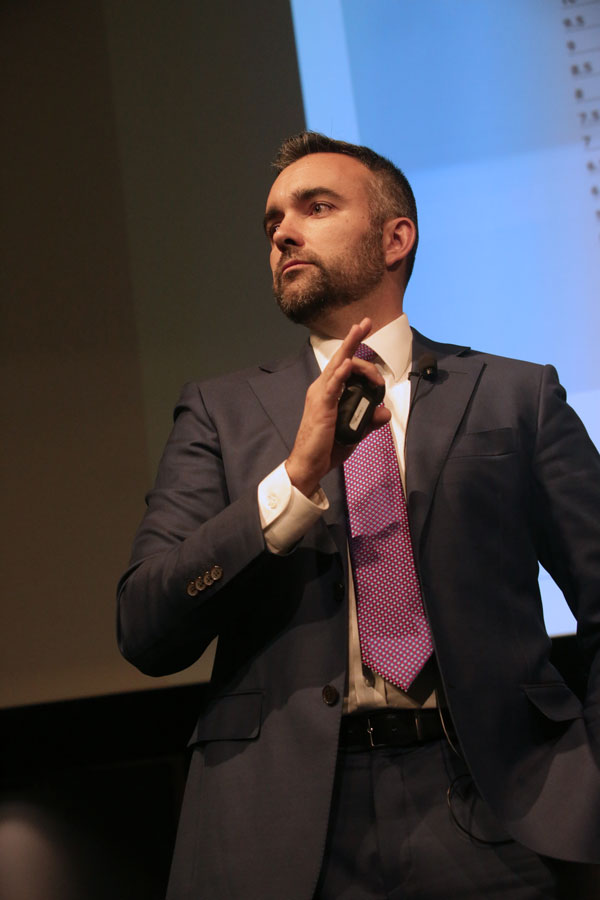New speaker series addresses vital local issues
See below: “New series focuses on major local problems“
Bernalillo County District Attorney Raúl Torrez gave a Sandia audience some sobering facts at the inaugural session of the Community Engagement Speaker Series.
“The reality is, you’re living in a community with a very serious crime problem,” Torrez said.
Torrez candidly discussed crime in the Albuquerque metro area and how past anti-crime efforts have fallen short, and he introduced a few ideas, including ways to ameliorate the early childhood trauma that often turns someone toward crime. Community Involvement and Associate Labs Director for Mission Assurance Mark Sellers hosted the session at the Schiff Auditorium.
Torrez said between 2014-2016, Albuquerque experienced the greatest increase in crime of any of the 30 largest U.S. cities, according to the FBI’s Uniform Crime Reports.

In that two-year period, Albuquerque showed a 26 percent increase in all crime, violent crime and property crime, and a staggering 102 percent increase in car thefts, making it the No. 1 U.S. city for auto theft.
Also alarming, Torrez said, is that crime rates are coming down in most larger cities, while Albuquerque’s continues to rise.
Torrez said one barrier to addressing the problem are shortcomings in the system of investigating crimes and processing criminals, which is organized chronologically based on the court system calendar — not the most efficient way to fight crime or assess risks for future crime, he said.
“That means that the most dangerous person in an investigator’s stack of cases to be investigated could be 20 cases deep. Right now there’s no way to address that,” Torrez said.
Crime in Albuquerque hits close to home for Sandia/New Mexico. The International District, located just northwest of the Wyoming gate, has the greatest concentration of crime in the city. With less than 7 percent of the metro area’s population, it has 27 percent of murders, 20 percent of carjackings and 37 percent of nonfatal shootings. Torrez added that 32 percent of those arrested for robbery come from that area, so he wants to expand efforts there, both for law enforcement and community support.
Torrez said his office doesn’t have a way to share electronic information with other parts of the criminal justice system due to system incompatibility, which leads to collaboration problems.
“We still use WordPerfect,” he told the shocked crowd.
A Sandia researcher has been working with Torrez’s office to find ways to improve data analysis and visualization. The office has hired a programmer to help address some of the data sharing and analysis problems.
Overall, Torrez’s office is looking for ways to focus on the small number of people who commit the most crimes. The goal, Torrez said, is that “if you’re going to be a prolific overperforming criminal, you’re entitled to your own personal prosecutor. We’re going strive for VIP service.”
In addition to focusing time and resources on those overperformers, Torrez and his office seek to chip away at the mental health and child trauma issues that can often put someone on the path to prison.
“The community will pay for these kids and these broken families one way or another. The question is, are we going to wait until something horrific happens, and I’m left trying console a family after someone’s been killed, and I must send someone to prison? Or are we going to start thinking differently and making investments in ourselves and our communities to make a difference in the lives of kids and families.”
A significant risk for committing crime later in life is experiencing multiple adverse childhood experiences, early traumatic events that reshape people’s lives, such as abuse, violence and discrimination. Torrez said about 75 percent of male and 87 percent of female incarcerated juveniles have experienced five or more such incidents in their life.
“In my view, when you’re talking about mental health and addiction issues later in life, what you’re talking about is undiagnosed, untreated and unrecognized childhood trauma experienced sometime between birth and 7 years old,” he said.
Torrez is the co-chair of Mission: Families, a new program of the United Way of Central New Mexico focused on improving family stability.
“It’s not about giving prosecutors or the mayor toys. It’s about making early and sustained investments in the kids of this community.” It costs $45,250 per year to house an inmate in prison, Torrez said.
“The community will pay for these kids and these broken families one way or another. The question is, are we going to wait until something horrific happens, and I’m left trying console a family after someone’s been killed, and I must send someone to prison? Or are we going to start thinking differently and making investments in ourselves and our communities to make a difference in the lives of kids and families,” Torrez said.
Torrez is an Albuquerque native, a Harvard and Stanford graduate, and a former federal prosecutor and senior adviser to the Department of Justice in President Obama’s administration.
Helen Wertheim, co-chair of Mission: Families, followed his talk with a discussion of the issues that families face, which often leave children unable to succeed in school.
Sandia employees can watch the archived talk online.
New series focuses on major local problems
Over the next year, a variety of speakers who represent organizations that are tackling some of Albuquerque’s most significant issues, such as poverty, education and welfare will visit Sandia and talk about their community work through the new Community Engagement Speaker Series, says organizer Roberta Rivera of Community Involvement.
Ed Rivera, CEO of United Way of Central New Mexico, provided details to the audience about the charity’s commitment to community change and discussed Sandia’s long-standing role in fostering change.
Since 1957, Sandia has contributed $107 million to the community through the United Way, along with many board chairs and volunteers, Rivera said.